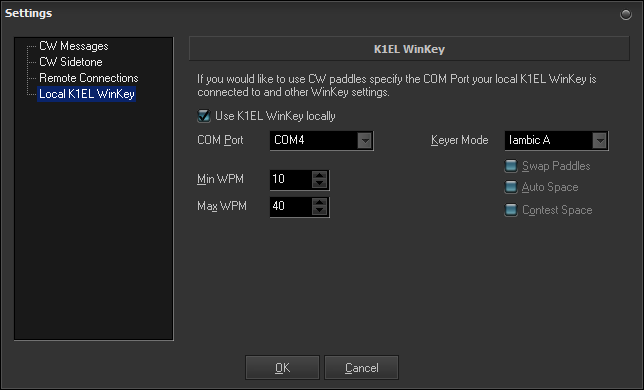Client Settings - Local K1EL WinKey
Using CW paddles is optional with RemoteCW but you can. A K1EL WinKey attached to a COM Port on your client computer is needed then. No other CW keyers are supported by this software. You can connect and use your local K1EL WinKey by setting the right COM Port here. Baud rate and all other serial port parameters are set internally. Min WPM, Max WPM and Speed are synchronized with your remote server WinKey.
Be sure to set the right COM Port your K1EL WinKey is attached to and be sure to check the Use K1EL WinKey checkbox.
There are a handful of WinKey parameters that can be set here if this instance of RemoteCW is running as client.
The CW speed range can be defined here with the Min WPM and Max WPM values. The actual CW speed can be changed at any time, even during transmission.
In either iambic Keyer Mode, alternating dits and dahs are sent while both paddles are held closed. In mode B, an extra alternate dit or dah is sent after both paddles are released. In Ultimatic mode, when both paddles are pressed, the keyer will send a continuous stream of whichever paddle was last pressed. Swap Paddles is a nice feature to have when right and left handed ops want to share the same keyer. The Keyer Mode and Swap Paddles options make sense only if you use paddles on the remote base station.
Here is how Auto Space works: If you pause for more than one dit time between a dit or dah WinKey will interpret this as a letter-space and will not send the next dit or dah until full letter-space time has been met. The normal letter-space is 3 dit spaces. WinKey has a paddle event memory so that you can enter dits or dahs during the inter-letter space and WinKey will send them as they were entered. With a little practice, autospace will help you to send near perfect Morse.
WinKey supports Contest spacing which reduces the wordspace time by one dit. Instead of 7 dits per wordspace, Contest spacing selects six dits per wordspace
Back to Documentation
